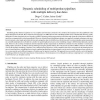Free Online Productivity Tools
i2Speak
i2Symbol
i2OCR
iTex2Img
iWeb2Print
iWeb2Shot
i2Type
iPdf2Split
iPdf2Merge
i2Bopomofo
i2Arabic
i2Style
i2Image
i2PDF
iLatex2Rtf
Sci2ools
CCE
2008
2008
Dynamic scheduling of multiproduct pipelines with multiple delivery due dates
Scheduling product batches in pipelines is a very complex task with many constraints to be considered. Several papers have been published on the subject during the last decade. Most of them are based on large-size MILP discrete time scheduling models whose computational efficiency greatly diminishesforratherlongtimehorizons.Recently,anMILPcontinuousproblemrepresentationinbothtimeandvolumeprovidingbetterschedulesat muchlowercomputationalcosthasbeenpublished.However,allmodel-basedschedulingtechniqueswereappliedtoexamplesassumingastaticmarketenvironment,ashortsingle-periodtimehorizonandauniquedue-dateforalldeliveriesatthehorizonend.Incontrast,pipelineoperatorsgenerally use a monthly planning horizon divided into a number of equal-length periods and a cyclic scheduling strategy to fulfill terminal demands at period ends. Moreover, the rerouting of shipments and time-dependent product requirements at distribution terminals force the scheduler to continuously update pipeline operations. To ...
| Added | 09 Dec 2010 |
| Updated | 09 Dec 2010 |
| Type | Journal |
| Year | 2008 |
| Where | CCE |
| Authors | Diego C. Cafaro, Jaime Cerdá |
Comments (0)

